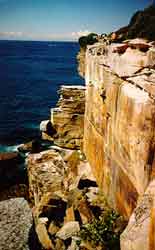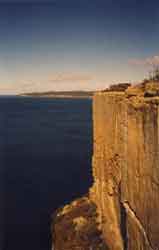| Rock Climbing Art of Climbing |
|||||
Moving to Australia recently opened a virtual climbing heaven for me. In Delhi, where it all began, I was mainly involved with bouldering. I had never worn a climbing harness...didn't know what a climbing rope was...and had never seen anyone climbing with a rope. I had no idea that people were so crazy for the Buzz that they even had special shoes designed to help you climb rocks! I would just take the thinnest joggers I had, and set off. I thought that you climbed as well as you could, and if you thought a climb was too dangerous for you, then you didn't climb. Simple. It never occurred to me that the risk of the climb could be reduced with technology and equipment. In fact what I loved about climbing was that it did not need any equipment. There was just the rock and I - pure nature - nothing artificial between the rock and me. I only learnt later that rock climbing was an immensely popular sport in the West and that they had devised a very sophisticated system of grading the difficulty level and the dangerousness of the climb. |
Rock Climbing • An Introduction • Ascent Of Balasari • Trance Climbing • Rock Climbing - Sites • The Buzz of Rock
Adventure activities | ||||
 I was quite amazed to discover that each climb had its own name, and each different route on a rock had a different name. If you are climbing a particular rock face its one climb, but if you climb the same rock a metre to your right or left, its a different climb.....wierd!
I was quite amazed to discover that each climb had its own name, and each different route on a rock had a different name. If you are climbing a particular rock face its one climb, but if you climb the same rock a metre to your right or left, its a different climb.....wierd!
As a result of my lack of exposure to the sport, I had never dared to climb any tough climbs higher than 10-15 meters, from where I could, and often did, jump when I got into trouble. Undoubtedly, I could have smashed my head or at least broken a few bones, if I had not landed perfectly. I had always managed to pull it off, interpreting it as a boon from the Gods of the Rocks and believing that I had divine patronisation. I thought it was not possible to climb higher if you have a loving family, thoughts and images of whom flashed before your eyes every time you were stuck halfway up a wall, losing your desperate struggle to pull your body weight on a fingertip hold, panic-struck while surveying the best landing options. Every jump was a nerve wracking few moments from when you know you are stuck and not going to be able to make it any further up, through the desperate scanning, the jump and the final landing, until your body has stopped shaking from the Adrenaline, though your mind is still in a state of numb shock. Out here in Oz, I discovered the "sport" of rock climbing. I played tennis and basketball - those were sports, not rock climbing. Here people go out rock climbing with the kind of preparation and equipment required to lay siege to a fortress. I discovered all sorts of wierd gadgets and equipment that somehow saves your life when you fall or jump off the rock. How was this possible?!?!
I was intrigued by all the equipment, not to mention the fuss. Gradually my amazement and disapproval melted as I saw the practical benefits of some of the practices here. I certainly felt a thousand times safer climbing at the end of a rope than climbing at the end of my wits! And wow, when I fell, I did not have to worry about how flat the ground below was because I would never get there, the rope would hold me as taut as a stretched bicep, and I could continue my climb from where I flew off. I wasn't sure whether that was equivalent to cheating, considering the debate about it. Soon, I started leading. That involves taking the rope up behind you as you climb, carrying equipment with you on your way up, placing stuff into cracks and natural holes and clipping your rope into those gadgets so that you would be safe. Well that's the theory of it anyway, but if everything went according to theory, rock climbing would not raise as many eyebrows as it does. Equipment is not failsafe and people DO fall and lives ARE lost, but that is an occupational hazard for a rock climber. No doubt the risk to life and limb adds to the buzz. I doubt if the BUZZ would be anything more than a mosquito buzzing if the risk was absent from the rock. I have climbed vertical walls that are a hundred feet high and made moves I could only have dream about, if it had not been for the fact that I was reasonably safe if I should fail. Knowing that, I can push myself that much farther to risk it all on a monster move, because I know there is a nylon rope sticking to me that will somehow stop my fall and let me live to see another sunshine. Without safety equipment, failure on a high climb meant almost certain death on impact. Images of my loving family still hound my frantic brain when I am stuck up high on a gravity defying climb. Controlling fear is certainly much easier when you can feel a stout rope trailing behind you and you know that your fall will be restricted to the last protection that u have on the rock and not to the hazy bottom that's jut barely visible as a mirage in the desert! Factsheet
|
|||||
Editor: Romola Butalia (c) India Travelogue. All rights reserved. |
|||||

 I soon learned about bolts, cams, quickdraws, friends, wires, karabiners, static and dynamic rope, bolts, runners and a myriad other things. The amazing thing that I discovered was that a lot of rocks had bolts in them. I was dumbstruck wondering why anyone would take the pains to climb up the rock and drill a hole to put a bolt in there, just so that they could be a little safer while climbing the rock.
I soon learned about bolts, cams, quickdraws, friends, wires, karabiners, static and dynamic rope, bolts, runners and a myriad other things. The amazing thing that I discovered was that a lot of rocks had bolts in them. I was dumbstruck wondering why anyone would take the pains to climb up the rock and drill a hole to put a bolt in there, just so that they could be a little safer while climbing the rock.